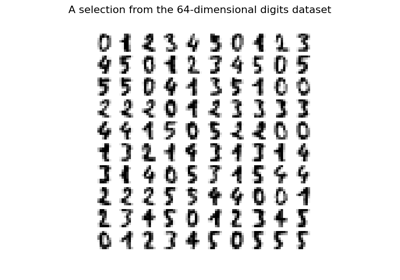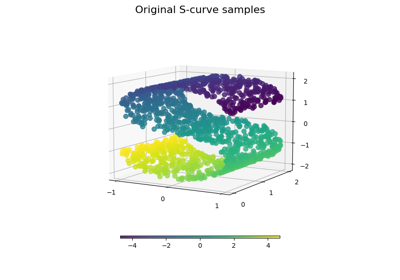SpectralEmbedding#
- class sklearn.manifold.SpectralEmbedding(n_components=2, *, affinity='nearest_neighbors', gamma=None, random_state=None, eigen_solver=None, eigen_tol='auto', n_neighbors=None, n_jobs=None)#
光谱嵌入用于非线性降维。
通过指定的函数形成亲和矩阵,并对相应的图拉普拉斯矩阵进行谱分解。 由此产生的变换由每个数据点的特征向量的值给出。
注意:这里实现的实际算法是拉普拉斯特征映射。
更多信息请参阅 用户指南 。
- Parameters:
- n_componentsint, default=2
投影子空间的维度。
- affinity{‘nearest_neighbors’, ‘rbf’, ‘precomputed’, ‘precomputed_nearest_neighbors’} or callable, default=’nearest_neighbors’
- 如何构建亲和矩阵。
‘nearest_neighbors’ : 通过计算最近邻图来构建亲和矩阵。
‘rbf’ : 通过计算径向基函数(RBF)核来构建亲和矩阵。
‘precomputed’ : 将
X解释为预计算的亲和矩阵。‘precomputed_nearest_neighbors’ : 将
X解释为预计算的最近邻稀疏图,并通过选择n_neighbors最近邻来构建亲和矩阵。callable : 使用传入的函数作为亲和度 该函数接收数据矩阵(n_samples, n_features) 并返回亲和矩阵(n_samples, n_samples)。
- gammafloat, default=None
rbf 核的核系数。如果为 None,gamma 将设置为 1/n_features。
- random_stateint, RandomState instance or None, default=None
用于在
eigen_solver == 'amg'时初始化 lobpcg 特征向量分解的伪随机数生成器,以及用于 K-Means 初始化。使用 int 使结果在不同调用中确定(参见 Glossary )。Note
当使用
eigen_solver == 'amg'时, 还需要通过np.random.seed(int)固定全局 numpy 种子以获得确定性结果。更多信息请参见 pyamg/pyamg#139。- eigen_solver{‘arpack’, ‘lobpcg’, ‘amg’}, default=None
使用的特征值分解策略。AMG 需要安装 pyamg。在非常大、稀疏的问题上可能会更快。如果为 None,则使用
'arpack'。- eigen_tolfloat, default=”auto”
拉普拉斯矩阵特征分解的停止准则。如果
eigen_tol="auto",则传递的容差将取决于eigen_solver:如果
eigen_solver="arpack",则eigen_tol=0.0;如果
eigen_solver="lobpcg"或eigen_solver="amg",则eigen_tol=None,这将配置底层的lobpcg求解器根据其启发式自动确定值。详情请参见scipy.sparse.linalg.lobpcg。
注意,当使用
eigen_solver="lobpcg"或eigen_solver="amg"时,tol<1e-5的值可能导致收敛问题,应避免使用。Added in version 1.2.
- n_neighborsint, default=None
用于构建最近邻图的最近邻数量。如果为 None,n_neighbors 将设置为 max(n_samples/10, 1)。
- n_jobsint, default=None
并行运行的作业数量。
None表示 1,除非在joblib.parallel_backend上下文中。-1表示使用所有处理器。更多详情请参见 Glossary 。
- Attributes:
- embedding_ndarray of shape (n_samples, n_components)
训练矩阵的光谱嵌入。
- affinity_matrix_ndarray of shape (n_samples, n_samples)
通过样本或预计算构建的亲和矩阵。
- n_features_in_int
在 fit 过程中看到的特征数量。
Added in version 0.24.
- feature_names_in_ndarray of shape (
n_features_in_,) 在 fit 过程中看到的特征名称。仅当
X的特征名均为字符串时定义。Added in version 1.0.
- n_neighbors_int
实际使用的最近邻数量。
See also
Isomap通过等距映射进行非线性降维。
References
On Spectral Clustering: Analysis and an algorithm, 2001 Andrew Y. Ng, Michael I. Jordan, Yair Weiss
Normalized cuts and image segmentation, 2000 Jianbo Shi, Jitendra Malik
Examples
>>> from sklearn.datasets import load_digits >>> from sklearn.manifold import SpectralEmbedding >>> X, _ = load_digits(return_X_y=True) >>> X.shape (1797, 64) >>> embedding = SpectralEmbedding(n_components=2) >>> X_transformed = embedding.fit_transform(X[:100]) >>> X_transformed.shape (100, 2)
- fit(X, y=None)#
拟合从数据X中得到的模型。
- Parameters:
- X{array-like, sparse matrix},形状为 (n_samples, n_features)
训练向量,其中
n_samples是样本的数量 而n_features是特征的数量。如果 affinity 是 “precomputed” X : {array-like, sparse matrix},形状为 (n_samples, n_samples), 将 X 解释为从样本计算得到的预计算邻接图。
- y忽略
未使用,为保持API一致性而存在。
- Returns:
- selfobject
返回实例本身。
- fit_transform(X, y=None)#
拟合模型从数据X中并转换X。
- Parameters:
- X{array-like, sparse matrix},形状为 (n_samples, n_features)
训练向量,其中
n_samples是样本的数量 和n_features是特征的数量。如果 affinity 是 “precomputed” X : {array-like, sparse matrix},形状为 (n_samples, n_samples), 将 X 解释为从 样本计算的预计算邻接图。
- y忽略
未使用,为保持API一致性而存在。
- Returns:
- X_newarray-like,形状为 (n_samples, n_components)
训练矩阵的谱嵌入。
- get_metadata_routing()#
获取此对象的元数据路由。
请查看 用户指南 以了解路由机制的工作原理。
- Returns:
- routingMetadataRequest
MetadataRequest封装的 路由信息。
- get_params(deep=True)#
获取此估计器的参数。
- Parameters:
- deepbool, 默认=True
如果为True,将返回此估计器和包含的子对象(也是估计器)的参数。
- Returns:
- paramsdict
参数名称映射到它们的值。





